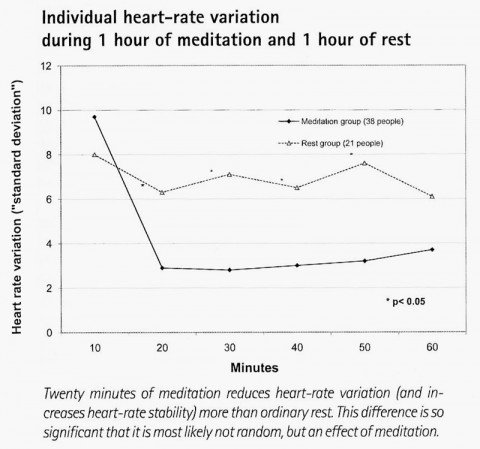Überblick über die Meditationsforschung
In einer groß angelegten amerikanischen Überblick über Meditationsforschung wurde 31 Mal Bezug auf Acem-Meditation genommen; dabei wurden sieben Studien über Acem-Meditation evaluiert.
Die 500-seitige Besprechung »Meditation Practices for Health: State of the Research« (Gesundheitsfördernde Meditationspraktiken: Der Stand der Forschung) von Ospina et al. wurde von unabhängigen Forschern im Auftrag des Büros für Gesundheitsforschung und –qualität des US-Gesundheitsministeriums zusammengestellt. Der Großteil der Studien beschäftigt sich mit Bluthochdruck, Herzerkrankungen und Drogenmissbrauch. Der Überblick kommt zu dem Schluss, dass Meditation positive Auswirkungen auf Bluthochdruck und andere Probleme hat. Er ist in seiner kompletten Form hier (pdf) erhältlich.
Der norwegische Arzt und Wissenschaftler Erik E. Solberg, ein Fachmann für innere Medizin, Kardiologie und Sportmedizin, ist mit acht Veröffentlichungen in der Referenzliste vertreten. Seine Doktorarbeit aus dem Jahre 2004 behandelt vornehmlich die psychophysiologischen Effekte der Acem-Meditation.
Seine Thesen sind im kürzlich erschienenen Buch: Fighting Stress: Reviews of Meditation Research. (Kampf gegen den Stress: Ein Überblick über die Meditationsforschung) zusammengefasst. Darin sind auch allgemeinverständliche Besprechungen weiterer Meditationsforschungsprojekte enthalten.
Der weitere Artikel existiert bisher leider nur in englischer Sprache.
Winding down the brain waves with Acem-Meditation
Experienced Acem meditators display a considerably larger amount of slow brain waves when they meditate than during ordinary rest. This includes both alpha waves, which are typical of relaxed wakefulness, and theta waves, which may indicate deeper relaxation. Typically, theta waves occur in frontal areas of the brain, while alpha waves occur further back.
(See Jim Lagopoulos, Jian Xu, Inge Rasmussen, Alexandra Vik, Gin S. Malhi, Carl F. Eliassen, Ingrid E. Arntsen, Jardar G. Sæther, Stig Hollup, Are Holen, Svend Davanger, and Øyvind Ellingsen, Increased Theta and Alpha EEG Activity during Nondirective Meditation, The Journal of Alternative and Complementary Medicine, vol. 15, no. 11, 2009, pp. 1187-1192.)
A milestone has been reached: First PhD on Acem Meditation
In 2004, the first doctoral thesis on Acem Meditation was successfully defended at the Faculty of Medicine, University of Oslo, Norway. In seven studies, Erik Ekker Solberg explored the psychobiological effects of Acem Meditation.
Dr. Solberg is a specialist in internal medicine, cardiology and sports medicine. Recently he started in his new post as senior consultant in cardiology in an Oslo hospital. He has practised Acem Meditation since 1971 and has been an instructor in Acem since 1975. He lives in an Oslo suburb with his wife and little daughter. During the last twelve years, he has spent most of his time working on his thesis and admits that he is relieved the work has now borne fruit. Read more here.
Let the heart relax with Acem Meditation
Acem Meditation reduces heart rate more strongly and stably than ordinary rest, and long meditations enhance the effect. A slow heart rate is usually considered to indicate relaxation. In a study comparing advanced Acem meditators with a control group that rested without meditating, the average heart rate dropped more markedly for the meditators than for the control group. For the meditators, average heart rate continued to drop during the second hour of meditation. (See Erik E. Solberg, Øivind Ekeberg, Are Holen, Frank Ingjer, Leiv Sandvik, Per A. Standal, Agneta Vikman, Hemodynamic Changes During Long Meditation, Applied Psychophysiology and Biofeedback, Volume 29, Issue 3, September 2004, Pages 213 – 221.)
Rest without sleep with Acem Meditation
Advanced practitioners of Acem Meditation have higher levels of melatonin than non-meditators. On the other hand, melatonin levels decrease markedly during long meditation, but not during ordinary rest. These results show that neurotransmitters such as melatonin (but not serotonin, which produced the same results in meditators and non-meditators) may play a role in producing the results of meditation. They also indicate that the relaxation produced by meditation is different from that produced by sleep, when melatonin levels increase. (See Erik E. Solberg, Are Holen, Øivind Ekeberg, Bjarne Østerud, Ragnhild Halvorsen, Leiv Sandvik, The effects of long meditation on plasma melatonin and blood serotonin, Medical Science Monitor, 2004; 10(3): CR96-101.)
Reducing fatigue with Acem Meditation
A study concludes that Acem Meditation may reduce the amount of lactate – one of the main indicators of physical fatigue – after exercise. 31 male runners were randomly divided into one group practising Acem Meditation, one practising autogenic training, and one control group that did not practise anyof the methods. It turned out that after 6 months of meditation training, post-exercise lactate was significantly reduced in the meditation group compared with the control group. (See Solberg EE et al. Stress reactivity and recovery to a standardized exercise bout – a study of 31 runners practising relaxation techniques. British Journal of Sports Medicine 2000; 34:268-272.)
Reducing stress with Acem Meditation
Another study compared the immune system of runners practising Acem Meditation with runners not practising Acem Meditation. Blood samples were drawn before, immediately after (a measure of reactivity to stress), and (as a measure of recovery) two hours after a half-marathon race. Before the race, the meditating runners had lower lymphocyte counts than those who did not practise meditation, perhaps indicating an immune system less influenced by stress. (See Solberg EE, Halvorsen R, Holen A. Effect of meditation on immune cells. Stress Medicine 2000; 16:185-190.)
On target with Acem Meditation
A study showed that marksmen who had learned to meditate improved their results in competition marksmanship. The control group, which had not learned the technique, showed no improvement. The study indicates that Acem Meditation reduces the level of stress in tense and demanding situations. This is obviously of benefit not only for marksmen, but for everyone who confronts stressful situations in their professional careers or other parts of their daily lives. (See “The effect of meditation on shooting performance”, by Solberg EE, Berglund KA, Engen ? Ekeberg ? Loeb M. British Journal of Sports Medicine 1996; 30:1-5)
Better health with Acem Meditation
Acem Meditation has clear physiological effects. When athletes train hard and compete, the immune system is temporarily weakened. A study indicates that runners who practised Acem Meditation for half a year, strengthened their immune systems compared to runners who had not learned to meditate. Acem Meditation reduces the unfavourable effect of stress on the immune system, not only for runners, but for everyone who experiences stress. (See “A modulator of the immune response to physical stress? A brief report”, by Solberg EE, Halvorsen R, Sundgot-Borgen J, Ingjer F, Holen A, British Journal of Sports Medicine 1995; 29:255-57)
On track with Acem Meditation
A constantly changing daily rhythm means that the locomotive engineers often suffer from sleep disorders, and they have a high frequency of heart disease. A study showed that Acem Meditation reduced blood pressure, fatty substances (e.g. cholesterol) in the bloodstream, psychological ailments, as well as improving sleep and the general quality of life. Another technique, called progressive relaxation, also lead to some of these results, but not to the same degree as Acem Meditation. (See “Acem Meditation beneficial for stressed locomotive engineers”, by Pär Westlund, Dyade 2/1993:36-51.)

